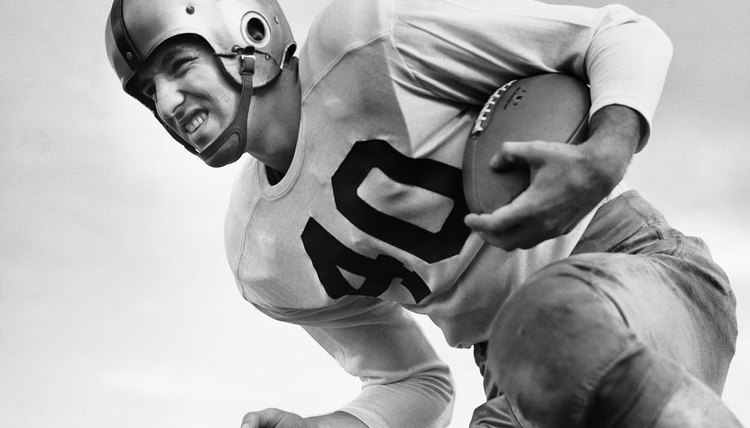Football Helmet Safety Improvements

Football players are regularly involved in collisions that exert forces at twice the energy of a crash test dummy hitting a wall at 35 mph. A college football player may take around 1,000 shots to the helmet every season, while a pro might get 1,500. As players get bigger and faster these collisions only worsen, and as they do, scientists and engineers continue to develop technology to keep players as safe as possible.
Put a Lid on It
The grainy, black-and-white footage of football’s early years stars players adorned in rudimentary leather helmets -- those who bothered to wear a helmet at all, that is. John Riddell developed the first plastic helmet in 1939 and added chinstraps the following year. Still, players continued to play without headgear until the National Football League required that all players wear helmets in 1943. By 1955, those plastic helmets were outfitted with a single-bar facemask and by 1962 facemasks were on all NFL helmets. Riddell added air bladders to their plastic shells in 1971 to help soften the impact of collisions.
Solving the Riddell
Riddell became an official partner of the NFL in 1989, and made further strides in 2002 with an advancement called Concussion Reducing Technology. The Riddell 360 model, released in 2011, added extra padding around the front and sides of the helmet, and took out the screws from the forehead area to increase the flexibility of the facemask. Riddell also patented Head Impact Telemetry System (HITS) to evaluate the effectiveness of their products and curb direct future research and development.
Competition Heats Up
As concussions entered the discourse surrounding player safety, other companies threw their hats -- or helmets -- into the ring. Xenith's X2 helmet replaced traditional foam padding with air-filled cylinders. Schutt’s Ion 4D model added a urethane cushion, while Rawlings added room between the helmet’s shell and the player’s head to accommodate more padding in its Quantum Plus model. Bill Simpson, recognized as the “Godfather of Safety” in auto racing, released his SGH Helmet in 2011. It was made of a carbon fiber and Kevlar shell over a layer of proprietary adaptive foam, making it the lightest on the market that year.
Protecting the Future
Kevin Guskiewicz, a professor of sports science at the University of North Carolina suggests it “might be impossible to design a helmet that completely eliminates concussions.” Peter Halldin, a biomechanics engineer at the Royal Institute of Technology in Stockholm, Sweden, began trying to prove Guskiewicz wrong in 2001. His Multidirectional Impact Protection System (MIPS) mimics the human head’s natural protective system. In Halldin's design, a helmet’s shell is separate from the inside protection. This allows the shell to rotate, while the inner protection stabilizes the player’s head. MIPS technology reduced brain rotation, the force attributed to causing concussions, by as much as 50 percent.
References
Writer Bio
Brian Lancette is a sports, travel and comedy writer based in Chicago by way of Northwest Wisconsin. His most recent work includes running youth baseball camps with the Boston Red Sox and Chicago Cubs. Lancette graduated from the University of Wisconsin (Eau Claire) with a degree in history and global studies.
